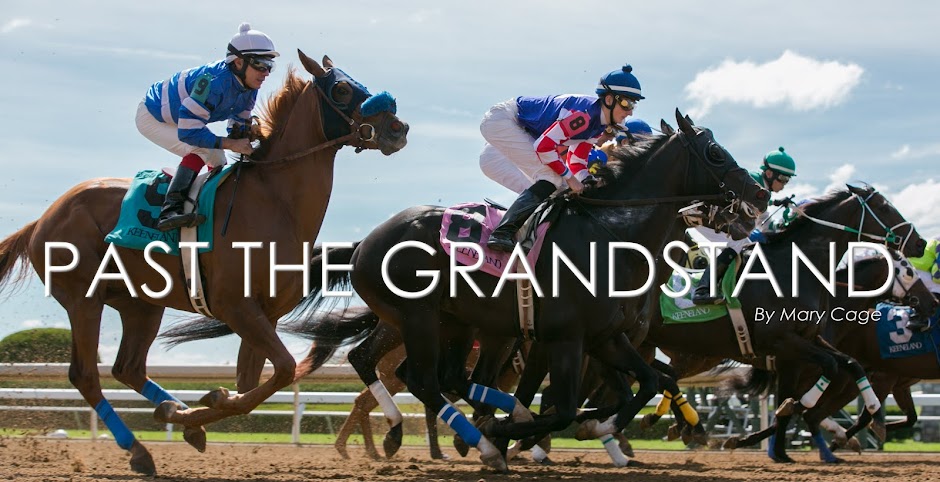An athletic chestnut boasting a
white star on his forehead, Easy Goer was nearly a second coming of his sire,
the great Alydar. Not only did he bear a physical resemblance to his sire, but
his career would encounter many of the same heartaches. Alydar is known for his
rivalry with 1978 Triple Crown winner Affirmed, a champion to which he finished
second in all three of the legs of that year’s epic Triple Crown. Easy Goer’s
name also carries the legacy of a rivalry: his with Sunday Silence, winner of
the 1989 Kentucky Derby (GI) and Preakness Stakes (GI).
Just as Alydar was a homebred for the legendary Calumet Farm, Easy Goer was a
homebred for the well-known Ogden Phipps, a stockbroker and tennis player who
owned a plethora of superb Thoroughbred racehorses. Placed in the barn of Shug McGaughey, Easy Goer followed in the steps of his sire as a two-year-old,
winning the Champagne Stakes (GI). But unlike Alydar, Easy Goer’s campaign
earned him the Eclipse Award for Champion Two-Year-Old Male.
Easy Goer was made the early favorite for the Kentucky Derby, but was second in the Run for the Roses over a muddy track behind the West Coast-based Sunday Silence. For Phipps and McGaughey, all their dreams of winning the Derby with the colt – hopes that had accumulated for months – came to an abrupt halt.
Nonetheless, they continued to pursue the rest of the Triple Crown races with Easy Goer. Two weeks later, Easy Goer met up with Sunday Silence yet again, this time in the Preakness Stakes (GI) at Pimlico Race Course in Maryland. Perhaps the race that defined their rivalry, the 1989 Preakness has been heralded as one of the greatest races of all-time.
Seizing an early lead near the end of the backstretch, Easy Goer was two lengths ahead of Sunday Silence as the field entered the far turn. But around the bend, the Derby winner drew even with Easy Goer to the champion juvenile’s outside, edging away from him near the culmination of the curve. But Easy Goer found more at the quarter pole and, rallying along the rail, refused to concede to Sunday Silence. Down the lane, the rivals dueled and although Easy Goer gained a minor lead mid-stretch, Sunday Silence was able to surpass his opponent within the final strides, capturing the race by a narrow margin.
With his victory, Sunday Silence had allowed the dream of a Triple Crown triumph to survive. It had been 11 years since a horse had won the Triple Crown. That horse was none other than Affirmed, Alydar’s arch nemesis that finished just ahead of Easy Goer’s sire in each of the Triple Crown races, leaving Alydar to be the 1978 Triple Crown “runner-up.”
But Easy Goer had not yet attained revenge. The Shug McGaughey trainee proceeded on to the Belmont Stakes (GI), the final and most grueling test of the Triple Crown series. On race day, nearly 65,000 filed into the gates of the expansive New York track with hopes of witnessing Sunday Silence capture the Triple Crown.
Phipps, McGaughey, and Easy Goer saw this as the perfect stage to finally avenge their losses to Sunday Silence. Easy Goer did not get revenge lightly, either. Before the crowd that watched anxiously, hoping for a Triple Crown triumph, Easy Goer transformed the Belmont into a tour de force. Swallowing up Sunday Silence with imposing strides around the far turn, Easy Goer drew off effortlessly, leaving his rival and the remainder of the field 8 lengths behind in the second fastest Belmont ever contested, a time second only to the legendary Secretariat.
Before the Belmont, the 1989 Triple Crown had been laced with disappointment for Phipps and McGaughey. Entering the prestigious three-race series with confidence surrounding their champion colt, losses in the Derby and Preakness were heartbreaking, terminating their anticipation of Easy Goer’s success each time Sunday Silence’s black nose finished ahead of their son of Alydar. But the Belmont provided a day of redemption, a day on which their talented colt could finally display his true brilliance, upsetting Sunday Silence when all eyes were fixed upon the two rivals.
The disappointment of the 1989 Triple Crown has likely since haunted Phipps and McGaughey. Wins in the Derby and Preakness eluded them and until this year’s Run for the Roses, they could only dream of standing in the winner’s enclosure on the first Saturday of May. But now Orb has entered the picture.
 |
| Orb Photo by Brittlan Wall |
Owned by Phipps Stable (headed by the son of the late Ogden Phipps, Ogden Mills “Dinny”
Phipps) and Phipps’ cousin, Stuart Janney III, Orb presented these owners – as well
as McGaughey – with their first Kentucky Derby victory. With his triumph, Orb
has allowed the racing world to step back into the “golden age” of the Phipps
and Janney families. Along with these names comes the remembrance of horses like
the all-time greats Ruffian,
Personal Ensign, and, of course, Easy Goer. Orb’s team, in just two words, is
old school.
So now Orb approaches the Preakness and the remainder of the Triple Crown with these classic connections along for the ride. But in comparison to Easy Goer, the roles have been reversed. The opponents aligned to challenge Orb will attempt to spoil his Triple Crown bid and he, the Derby winner rather than the defeated Derby favorite, will strive to repel these competitors in an effort to end the Triple Crown drought – a drought that dates back to 35 years ago when Affirmed conquered Alydar – Easy Goer’s sire. This makes it seem as though the course of the Triple Crowns contested since 1978 have come full circle. Is this finally the year that racing will rejoice in the presence of the first Triple Crown victor in decades? It only seems fitting that these connections would be the ones to end the drought.

No comments:
Post a Comment